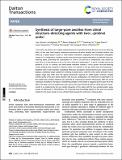Por favor, use este identificador para citar o enlazar a este item:
http://hdl.handle.net/10261/227513COMPARTIR / EXPORTAR:
 SHARE SHARE
 CORE
BASE CORE
BASE
|
|
| Visualizar otros formatos: MARC | Dublin Core | RDF | ORE | MODS | METS | DIDL | DATACITE | |

| Título: | Synthesis of large-pore zeolites from chiral structure-directing agents with two l-prolinol units |
Autor: | Gómez-Hortigüela Sainz, Luis CSIC ORCID ; Mayoral, Álvaro CSIC ORCID; Liu, Haining; Sierra, Teresa CSIC ORCID ; Vaquerizo, Laura; Mompeán, Cristina; Pérez-Pariente, Joaquín CSIC ORCID | Fecha de publicación: | 2020 | Editor: | Royal Society of Chemistry (UK) | Citación: | Dalton Transactions 49(28): 9618-9631 (2020) | Resumen: | In this work, we perform an in-depth experimental and computational study about the structure-directing effect of two new chiral organic quaternary ammonium dications bearing two N-methyl-prolinol units linked by a xylene spacer in para or meta relative orientation, displaying four enantiopure stereogenic centers in (S) configuration. Synthesis results show that the para-xylene derivative is an efficient structure-directing agent, promoting the crystallization of ZSM-12 (in pure-silica composition), beta zeolite (as pure-silica, or in the presence of Al or Ge), and a mixture of polymorphs C, A and B of zeolite beta (in the presence of Ge). In contrast, the meta-xylene derivative showed a much poorer structure-directing activity, yielding only amorphous materials unless Ge is present in the gel, where beta and polymorph C (together with A and B) zeolites crystallized. Molecular simulations showed that the para-xylene dication displays a cylindrical shape suitable for confining in zeolite pores, while the meta-xylene derivative has an angular shape that shifts from the typical dimensions required for 12MR zeolite channels. Despite enantio-purity of the para-xylene dication with (S,S,S,S) configuration, no enrichment in polymorph A of the zeolite beta samples obtained was observed by Transmission Electron Microscopy. With the aid of molecular simulations, the failure in transferring chirality to the zeolite is explained by the loose fit of this SDA in the large-pores of zeolite beta, and a lack of close geometrical fit with the chiral element of polymorph A, as evidenced by the very similar interaction of the cation with the two enantiomorphic space groups of polymorph A. Nevertheless, the molecular-level knowledge gained in this work can provide insights for the future design of more efficient SDAs towards the synthesis of chiral zeolites. | Versión del editor: | https://doi.org/10.1039/D0DT01834A | URI: | http://hdl.handle.net/10261/227513 | DOI: | 10.1039/D0DT01834A | ISSN: | 1477-9234 |
| Aparece en las colecciones: | (ICMA) Artículos (ICP) Artículos |
Ficheros en este ítem:
| Fichero | Descripción | Tamaño | Formato | |
|---|---|---|---|---|
| syntheunit.pdf | 7,32 MB | Adobe PDF |  Visualizar/Abrir |
CORE Recommender
WEB OF SCIENCETM
Citations
2
checked on 25-feb-2024
Page view(s)
134
checked on 24-abr-2024
Download(s)
84
checked on 24-abr-2024
Google ScholarTM
Check
Altmetric
Altmetric
Este item está licenciado bajo una Licencia Creative Commons

